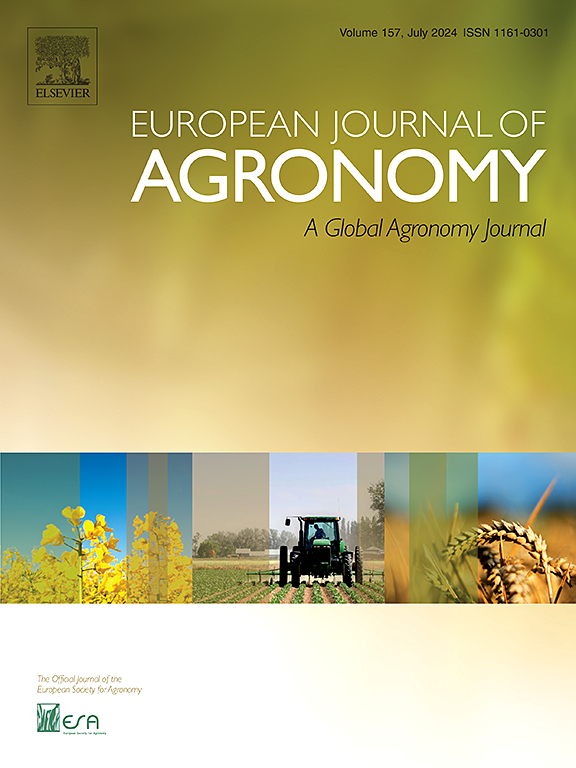Foliar zinc fertilization: Enhancing sorghum productivity and starch quality under zinc deficiency
IF 4.5
1区 农林科学
Q1 AGRONOMY
引用次数: 0
Abstract
Sorghum (Sorghum bicolor (L.) Moench), the fifth-largest cereal crop globally, faces productivity challenges due to soil zinc deficiency, which negatively impacts both yield and nutritional quality. This study aimed to evaluate the impact of foliar zinc fertilizer application on sorghum yield, grain filling dynamics, starch synthesis, and nutrient accumulation across two growing seasons. A comprehensive randomized field experiment was conducted with four treatments: a control (A1), foliar spray at the jointing stage (A2), at the heading stage (A3), and at both stages (A4). The zinc fertilizer was applied as a 0.2 % zinc sulfate solution at a rate of 800 L ha−1, equating to 1.6 kg of zinc ha−1. The results demonstrated that foliar application of zinc, especially at the jointing stage, significantly increased sorghum yield by 8.71 % and 9.22 % in 2021 and 2022, and 1,000-grain weight by 20.5 % and 16.5 %, respectively. This enhancement was attributed to the increased net photosynthetic rate and dry matter accumulation, which in turn boosted grain filling efficiency and starch synthesis. The upper panicle grains exhibited superior filling conditions, with the A2 treatment enhancing the upper grain weight by 12.67 % in 2021 and 6.30 % in 2022, respectively. The foliar zinc application notably elevated the activity of key enzymes involved in starch synthesis, such as ADP-glucose pyrophosphorylase (AGPase), starch branching enzyme (SBE), starch debranching enzyme (DBE), and soluble starch synthase (SS). Furthermore, the foliar application of zinc fertilizer significantly increased the zinc content in sorghum leaves and other organs, with the A2 and A4 treatments showing the highest enhancement. This increase in zinc content was accompanied by a positive effect on the absorption and accumulation of other essential nutrients, including nitrogen, phosphorus, and potassium, suggesting a synergistic role of zinc in improving overall plant nutrition. In summary, the foliar application of 0.2 % zinc sulfate fertilizer is an effective agricultural practice to improve sorghum yield and starch quality by enhancing photosynthesis, dry matter accumulation, and the activity of starch synthesis enzymes. These findings provide valuable insights for optimizing sorghum cultivation practices in regions prone to zinc deficiency.
叶片施锌:提高缺锌条件下高粱产量和淀粉品质
高粱(Sorghum bicolor, L.)全球第五大谷类作物Moench)由于土壤缺锌而面临生产力挑战,这对产量和营养质量都产生了负面影响。本研究旨在评价两个生长季节叶片施锌肥对高粱产量、籽粒灌浆动态、淀粉合成和养分积累的影响。采用对照(A1)、拔节期叶面喷施(A2)、抽穗期叶面喷施(A3)、两期喷施(A4) 4个处理进行综合随机田间试验。锌肥以0.2 %硫酸锌溶液以800 L ha−1的速率施用,相当于1.6 kg锌ha−1。结果表明,叶面施锌,尤其是拔节期,可显著提高高粱2021年和2022年产量8.71 %和9.22 %,千粒重分别提高20.5 %和16.5 %。这主要是由于净光合速率和干物质积累增加,从而提高了籽粒灌浆效率和淀粉合成。上部穗粒表现出较好的灌浆条件,A2处理在2021年和2022年分别使上部粒重提高12.67 %和6.30 %。叶面施锌显著提高了淀粉合成关键酶如adp -葡萄糖焦磷酸化酶(AGPase)、淀粉分支酶(SBE)、淀粉去分支酶(DBE)和可溶性淀粉合成酶(SS)的活性。此外,叶面施用锌肥显著提高了高粱叶片和其他器官锌含量,其中A2和A4处理的提高幅度最大。锌含量的增加对氮、磷、钾等其他必需营养素的吸收和积累也有积极影响,表明锌在改善植物整体营养方面具有协同作用。综上所述,叶面施用0.2% %硫酸锌肥是通过提高高粱光合作用、干物质积累和淀粉合成酶活性来提高高粱产量和淀粉品质的有效农业实践。这些发现为在容易缺锌的地区优化高粱栽培方法提供了有价值的见解。
本文章由计算机程序翻译,如有差异,请以英文原文为准。
求助全文
约1分钟内获得全文
求助全文
来源期刊

European Journal of Agronomy
农林科学-农艺学
CiteScore
8.30
自引率
7.70%
发文量
187
审稿时长
4.5 months
期刊介绍:
The European Journal of Agronomy, the official journal of the European Society for Agronomy, publishes original research papers reporting experimental and theoretical contributions to field-based agronomy and crop science. The journal will consider research at the field level for agricultural, horticultural and tree crops, that uses comprehensive and explanatory approaches. The EJA covers the following topics:
crop physiology
crop production and management including irrigation, fertilization and soil management
agroclimatology and modelling
plant-soil relationships
crop quality and post-harvest physiology
farming and cropping systems
agroecosystems and the environment
crop-weed interactions and management
organic farming
horticultural crops
papers from the European Society for Agronomy bi-annual meetings
In determining the suitability of submitted articles for publication, particular scrutiny is placed on the degree of novelty and significance of the research and the extent to which it adds to existing knowledge in agronomy.
 求助内容:
求助内容: 应助结果提醒方式:
应助结果提醒方式:


